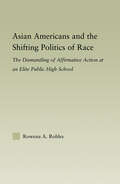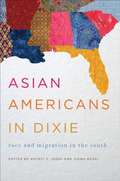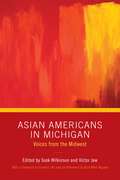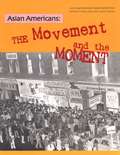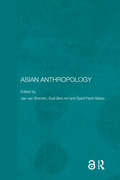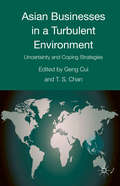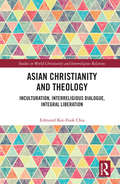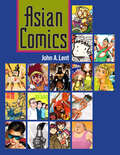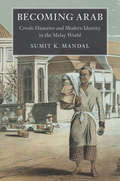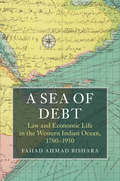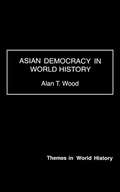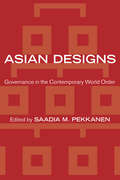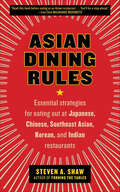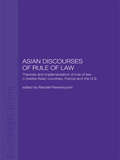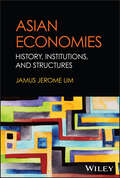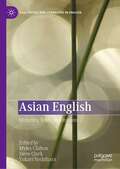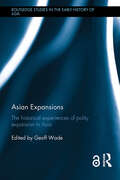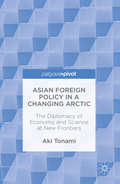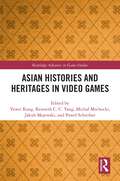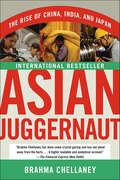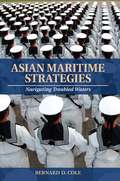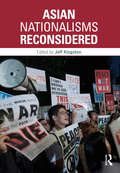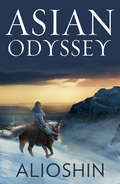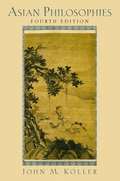- Table View
- List View
Asian Americans and the Shifting Politics of Race: The Dismantling of Affirmative Action at an Elite Public High School (Studies in Asian Americans)
by Rowena RoblesAsian Americans and the Shifting Politics of Race examines the political and discursive struggles around the dismantling of race-based admissions policies in an elite public high school in San Francisco. The book analyzes the arguments put forth by plaintiffs in and the media's depiction of the case, Brian Ho, Patrick Wong, & Hilary Chen v. SFUSD. The Ho lawsuit, filed by a group of Chinese Americans, challenged race-based admissions policies that were intended to ensure diversity by giving special consideration to African-American and Latino students. Robles argues that the Ho plaintiffs exploited the dominant racial construction of Asian Americans as model minorities to portray themselves as victims of discrimination, and relied on contrasting constructions of Black and Latino students as undeserving and unqualified beneficiaries of affirmative action. The decision in favor of the plaintiffs effectively ended school desegregation, racial balance, and affirmative action in San Francisco. In order to examine the consequences of the Ho decision on student attitudes, Robles spent four years studying and observing the first cohort of students to enter the high school after race was eliminated from admissions considerations.
Asian Americans in Dixie: Race and Migration in the South
by Khyati Y. Joshi Jigna DesaiExtending the understanding of race and ethnicity in the South beyond the prism of black-white relations, this interdisciplinary collection explores the growth, impact, and significance of rapidly growing Asian American populations in the American South. Avoiding the usual focus on the East and West Coasts, several essays attend to the nuanced ways in which Asian Americans negotiate the dominant black and white racial binary, while others provoke readers to reconsider the supposed cultural isolation of the region, reintroducing the South within a historical web of global networks across the Caribbean, Pacific, and Atlantic. Contributors are Vivek Bald, Leslie Bow, Amy Brandzel, Daniel Bronstein, Jigna Desai, Jennifer Ho, Khyati Y. Joshi, ChangHwan Kim, Marguerite Nguyen, Purvi Shah, Arthur Sakamoto, Jasmine Tang, Isao Takei, and Roy Vu.
Asian Americans in Michigan: Voices from the Midwest (Great Lakes Books Series)
by Sook Wilkinson Victor JewWhile the number of Asians in Michigan was small for a good portion of the state's history, many Asian-derived communities have settled in the area and grown significantly over time. In Asian Americans in Michigan: Voices from the Midwest, editors Sook Wilkinson and Victor Jew have assembled forty-one contributors to give an intimate glimpse into Michigan's Asian-American communities, creating a fuller picture of these often overlooked groups. Accounts in the collection come from a range of perspectives, including first-generation immigrants, those born in the United States, and third- and fourth-generation Americans of Asian heritage. In five sections, contributors consider the historical and demographic origins of Michigan's Asian American communities, explore their experiences in memory and legacy keeping, highlight particular aspects of community culture and heritage, and comment on prospects and hopes for the future. This volume's vibrant mix of contributors trace their ancestries back to East Asia (China, Japan, Korea, Taiwan), South Asia (Bangladesh, India, Pakistan), and Southeast Asia (Cambodia, Laos, Philippines, Thailand, Vietnam, and the Hmong). Though each contributor writes from his or her unique set of experiences, Asian Americans in Michigan also reveals universal values and memories held by larger communities. Asian Americans in Michigan makes clear the significant contributions by individuals in many fields--including art, business, education, religion, sports, medicine, and politics--and demonstrates the central role of community organizations in bringing ethnic groups together and preserving memories. Readers interested in Michigan history, sociology, and Asian American studies will enjoy this volume.
Asian Americans: The Movement And The Moment
by Steven Louie Glenn OmatsuCultural Writing. Asian American Studies. A wide-ranging collection of essays and material which documents the rich, little-known history of Asian American social activism during the years 1965-2001. This book examines the period not only through personal accounts and historical analysis, but through the visual record--utilizing historical prictorial materials developed at UCLA's Asian American Studies Center on Chinese, Japanese, Korean, Filipino, and Vietnamese Americans. Included are many reproductions of photos of the period, movement comics, demonstration flyers, newsletters, posters and much more.
Asian Anthropology (Anthropology of Asia)
by Syed Farid Alatas Eyal Ben-Ari Jan Van BremenAsian Anthropology raises important questions regarding the nature of anthropology and particularly the production and consumption of anthropological knowledge in Asia. Instead of assuming a universal standard or trajectory for the development of anthropology in Asia, the contributors to this volume begin with the appropriate premise that anthropologies in different Asian countries have developed and continue to develop according to their own internal dynamics. With chapters written by an international group of experts in the field, Asian Anthropology will be a useful teaching tool and a valuable resource for scholars working in Asian anthropology.
Asian Businesses in a Turbulent Environment: Uncertainty and Coping Strategies (AIB Southeast Asia)
by Geng Cui T. S. ChanAsian economies today command much attention from scholars and practitioners, yet they continue to face crises and challenges such as globalization, regional conflict, pressure for greater transparency and environmental protection to name but a few. Asian Businesses in a Turbulent Environment explores how Asian firms cope with these challenges, and the impact that rising above them will have on their growth prospects. Starting with a conceptual analysis of crises and their impact on local markets and societies, this book examines leadership styles for conflict management, as well as strategies adopted by various Asian firms including the location choice and entry mode, knowledge transfer, cultural shifts, social capital and knowledge development, and environmental management in the supply chain.
Asian Christianity and Theology: Inculturation, Interreligious Dialogue, Integral Liberation (Studies in World Christianity and Interreligious Relations)
by Edmund Kee-Fook ChiaThis book provides a comprehensive exploration of Asian Christianity and Theology, with emphasis on how it has developed in different parts of the continent and in the different eras, especially since the end of colonialism in Asia. Asian Theology refers to a unique way of theological reflection characterized by specific methodologies that evolved in postcolonial Asia. Premised on the thinking of Asian Church leaders and scholars, its focus is on the dialogue with the many cultures (inculturation), many religions (interreligious dialogue), and many poor (integral liberation) of Asia. The book looks at each of these ministries in detail, foregrounding Asian biblical hermeneutics, Christianity’s engagement with Hinduism, Confucianism, and Islam, Asian Women’s Theology, and the rise of Pentecostalism. The volume is valuable reading for scholars of religious studies, theology, world Christianity, Asian religions, and Asian studies.
Asian Comics
by John A. LentGrand in its scope, Asian Comics dispels the myth that, outside of Japan, the continent is nearly devoid of comic strips and comic books. Relying on his fifty years of Asian mass communication and comic art research, during which he traveled to Asia at least seventy-eight times and visited many studios and workplaces, John A. Lent shows that nearly every country had a golden age of cartooning and has experienced a recent rejuvenation of the art form. As only Japanese comics output has received close and by now voluminous scrutiny, Asian Comics tells the story of the major comics creators outside of Japan. Lent covers the nations and regions of Bangladesh, Cambodia, China, Hong Kong, India, Indonesia, Korea, Malaysia, Myanmar, Nepal, the Philippines, Singapore, Sri Lanka, Taiwan, Thailand, and Vietnam. Organized by regions of East, Southeast, and South Asia, Asian Comics provides 178 black-and-white illustrations and detailed information on comics of sixteen countries and regions—their histories, key creators, characters, contemporary status, problems, trends, and issues. One chapter harkens back to predecessors of comics in Asia, describing scrolls, paintings, books, and puppetry with humorous tinges, primarily in China, India, Indonesia, and Japan. The first overview of Asian comic books and magazines (both mainstream and alternative), graphic novels, newspaper comic strips and gag panels, plus cartoon/humor magazines, Asian Comics brims with facts, fascinating anecdotes, and interview quotes from many pioneering masters, as well as younger artists.
Asian Connections: Creole Histories and Modern Identity in the Malay World (Asian Connections)
by Mandal Sumit K.Sumit K. Mandal uncovers the hybridity and transregional connections underlying modern Asian identities. By considering Arabs in the Malay world under European rule, Becoming Arab explores how a long history of inter-Asian interaction was altered by nineteenth-century racial categorisation and control. Mandal traces the transformation of Arabs from familiar and multi-faceted creole personages of Malay courts into alienated figures defined by economic and political function. The racialisation constrained but did not eliminate the fluid character of Arabness. Creole Arabs responded to the constraints by initiating transregional links with the Ottoman Empire and establishing modern social organisations, schools, and a press. Contentions emerged between organisations respectively based on Prophetic descent and egalitarianism, advancing empowering but conflicting representations of a modern Arab and Islamic identity. Mandal unsettles finite understandings of race and identity by demonstrating not only the incremental development of a modern identity, but the contested state of its birth.
Asian Connections: Early Modern China and Northeast Asia
by Evelyn S. RawskiIn this revisionist history of early modern China, Evelyn Rawski challenges the notion of Chinese history as a linear narrative of dynasties dominated by the Central Plains and Hans Chinese culture from a unique, peripheral perspective. Rawski argues that China has been shaped by its relations with Japan, Korea, the Jurchen/Manchu and Mongol States, and must therefore be viewed both within the context of a regional framework, and as part of a global maritime network of trade. Drawing on a rich variety of Japanese, Korean, Manchu and Chinese archival sources, Rawski analyses the conflicts and regime changes that accompanied the region's integration into the world economy during the sixteenth and seventeenth centuries. Early Modern China and Northeast Asia places Sino-Korean and Sino-Japanese relations within the context of northeast Asian geopolitics, surveying complex relations which continue to this day.
Asian Connections: Law and Economic Life in the Western Indian Ocean, 1780–1950 (Asian Connections)
by Bishara Fahad AhmadIn this innovative legal history of economic life in the Western Indian Ocean, Bishara examines the transformations of Islamic law and Islamicate commercial practices during the emergence of modern capitalism in the region. In this time of expanding commercial activity, a m#65533;lange of Arab, Indian, Swahili and Baloch merchants, planters, jurists, judges, soldiers and seamen forged the frontiers of a shared world. The interlinked worlds of trade and politics that these actors created, the shared commercial grammars and institutions that they developed and the spatial and socio-economic mobilities they engaged in endured until at least the middle of the twentieth century. This major study examines the Indian Ocean from Oman to India and East Africa over an extended period of time, drawing together the histories of commerce, law and empire in a sophisticated, original and richly textured history of capitalism in the Islamic world.
Asian Democracy in World History (Themes in World History)
by Alan T. WoodTaking a comparative approach, Alan T. Wood traces the evolution of democracy from its origins in prehistoric times and describes democratic growth in thirteen Asian countries from Japan in East Asia to Pakistan in South Asia and examines key issues such as: * How does the democratic experience in Asia, in countries with unique and totalitarian political traditions, compare with democracies worldwide?* Is the aspiration to freedom universal or is it a product of western ideas and institutions?
Asian Designs: Governance in the Contemporary World Order
by Saadia PekkanenAsian nations are no longer "rising" powers in the world order; they have risen. How will they conduct themselves in world politics? How will they deploy their considerable and growing power individually and collectively? These questions are critical for global governance. Conventional wisdom claims that, lacking in institutions that accumulate and coordinate the massive economic and growing military strength of Asian nations, the Asian region will continue to punch below its weight in world politics; thin and patchy institutionalization results in political weakness. In Asian Designs, Saadia M. Pekkanen and her collaborators question and provide evidence on these core assumptions of Western scholarship. The book advances a new framework for debate and sophisticated examinations of institutional arrangements for several major issue areas in the world order—security, trade, environment, and public health.ContributorsVinod K. Aggarwal, University of California at BerkeleyC. Randall Henning, American University Keisuke Iida, University of TokyoPurnendra Jain, University of AdelaideDavid Kang, University of Southern California Saori N. Katada, University of Southern CaliforniaMin Gyo Koo, Seoul National UniversityKerstin Lukner, University of Duisburg-EssenTakamichi Tam Mito, Kwansei Gakuin UniversityJames Clay Moltz, Naval Postgraduate SchoolSaadia M. Pekkanen, University of WashingtonKim DoHyang Reimann, Georgia State UniversityKellee S. Tsai, Hong Kong University of Science and TechnologyMing Wan, George Mason University
Asian Dining Rules: Essential Strategies for Eating Out at Japanese, Chinese, Southeast Asian, Korean, and Indian Restaurants
by Steven A. ShawMost Asian restaurants are really two restaurants: one where outsiders eat, and one where insiders dine. So how can you become an insider and take full advantage of Asian cuisines? In this indispensable guide, dining expert Steven A. Shaw proves that you don't have to be Asian to enjoy a VIP experience—you just have to eat like you are. Through entertaining and richly told anecdotes and essays, Asian Dining Rules takes you on a tour of Asian restaurants in North America, explaining the cultural and historical background of each cuisine—Japanese, Chinese, Southeast Asian, Korean, and Indian—and offering an in-depth survey of these often daunting foodways. Here are suggestions for getting the most out of a restaurant visit, including where to eat, how to interact with the staff, be treated like a regular, learn to eat outside the box, and order special off-menu dishes no matter your level of comfort or knowledge.Steven Shaw—intrepid reporter, impeccable tastemaker, and eater extraordinaire—is the perfect dining companion to accompany you on your journey to find the best Asian dining experience, every time.
Asian Discourses of Rule of Law
by Randall PeerenboomRule of law is one of the pillars of the modern world, and widely considered necessary for sustained economic development, the implementation of democracy and the protection of human rights. It has however emerged in Western liberal democracies, and some people question how far it is likely to take root fully in the different cultural, economic and political context of Asia. This book considers how rule of law is viewed and implemented in Asia. Chapters on France and the USA provide a benchmark on how the concept has evolved, is applied and is implemented in a civil law and a common law jurisdiction. These are then followed by twelve chapters on the major countries of East Asia, and India, which consider all the key aspects of this important issue.
Asian Economies: History, Institutions, and Structures
by Jamus Jerome LimAn insightful and thorough exploration of the economies of Asia In Asian Economies: History, Institutions and Structure, seasoned economist and professor Jamus Jerome Lim provides a comprehensive discussion and incisive analysis of the economies of Asia. In addition to discussing the sharp contrasts between the region’s three major economies—China, India, and Japan—Lim also provides an overview of the rise of the Dragon economies of the East, to the resource-rich economies of the West. The book adopts a unique approach to the treatment of these economies, weaving in aspects of these countries’ economic geography and history, their idiosyncratic institutions and structures, along with providing a comparative and international perspective. The book offers: Careful emphasis on the geographic preconditions and enduring legacy of economic history on the contemporary and future prospects of each of the countries and regions discussed within Examinations of the importance of the political and economic institutions, as well as market and industrial structures, in shaping the trajectories of the economies considered in the book Discussions of the dramatic differences and similarities between the Asian economies, as well as how these differences shape these economies’ interactions with the rest of the worldPerfect for undergraduate and graduate students of economics, Asian Economies will also earn a place on the bookshelves of business and finance professionals seeking to understand the economies of the world’s most diverse and dynamic region.
Asian English: Histories, Texts, Institutions (Asia-Pacific and Literature in English)
by Steve Clark Myles Chilton Yukari YoshiharaContesting the idea that the study of Anglophone literature and literary studies is simply a foreign import in Asia, this collection addresses the genealogies of textual critique and institutionalized forms of teaching of English language and literature in Asia through the 19th and 20th centuries, along with an examination of how its present options and possible future directions relate to these historical contexts. It argues that the establishment of Anglophone literature in Asia did not simply “happen”: there were extra-literary and -academic forces at work, inserting and domesticating in Asian universities both the English language and Anglo-American literature, and their attendant cultural and political values. Offering new perspectives for ongoing conversations surrounding the globalization of Anglophone literature in literary and cultural studies, the book also considers the practicalities of teaching both the language and its canon of classic texts, and that the historical formation and shape of English studies in Asia offers lessons that relate not only to the discipline but also may be applied to the humanities as a whole.
Asian Expansions: The Historical Experiences of Polity Expansion in Asia (Routledge Studies in the Early History of Asia)
by Geoff WadeAsia as we know it today is the product of a wide range of polity expansions over time. Recognising the territorial expansions of Asian polities large and small through the last several millennia helps rectify the fallacy, long-held and deeply entrenched, that Asian polities have been interested only in the control of populations, not in expanding their command of territory. In countering this misapprehension, this book suggests that Asian polities have indeed been concerned with territorial control and expansion over time, whether for political or strategic advantage, trade purposes, defence needs, agricultural expansion or increased income through taxation. The book explores the historical experiences of a set of polity expansions within Asia, specifically in East and Southeast Asia, and, by examining the motivations, mechanisms, processes, validations and limitations of these Asian territorial expansions, reveals the diverse avenues by which Asian polities have grown. The chapters draw on these historical examples to highlight the connections between Asian polity expansion and centralised political structures, and this aids in a broader and more comprehensive understanding of Asian political practice, both past and present. Through these chapter studies and the integrative introduction, the book interrogates key concepts such as imperialism and colonialism, and the applicability and relevance of such terminology in Asian contexts, both historical and contemporary. Comparisons and contrasts with European historical expansions are also suggested. This book will be welcomed by students and scholars of Asian history, as well as by those with an interest in Asian interactions, international relations, polity expansion, Asia--Europe historical comparisons and globalisation.
Asian Foreign Policy in a Changing Arctic: The Diplomacy of Economy and Science at New Frontiers
by Aki TonamiThis book examines the growing interest by Asian states, which are normally considered as 'outsiders' in the Arctic governance system. Whilst existing research asserts that Asian states are mostly interested in the economic aspect of the changing Arctic, including its mineral and fossil sources and the opening up of new sea routes, the book argues that the relation between Asian states and the Arctic is much more complex and dynamic, grounded in their unique perspective on national security and the role of economic development in securing their national interests.
Asian Histories and Heritages in Video Games (ISSN)
by Paweł Schreiber Yowei Kang Yang, Kenneth C. C. Michał Mochocki Jakub MajewskiThis book explores the representations of national Asian histories in digital games. Situated at the intersection of regional game studies and historical game studies, this book offers chapters on histories and heritages of Japan, China, Iran, Iraq, Taiwan, South Korea, Indonesia, Singapore, Turkey, and Russia.The volume looks beyond the diversity of the local histories depicted in games, and the audience reception of these histories, to show a diversity of approaches which can be used in examining historical games– from postcolonialism to identity politics to heritage studies. It demonstrates various methodological approaches to historical/regional game studies: case studies of nationally produced historical games that deal with local history, studies of media reception of history/heritage-themed games, text-mining methods studying attitudes expressed by players of such games, and educational perspectives on games in teaching cultural heritage. Through the lens of videogames, the authors explore how nations struggle with the legacies of war, colonialism and religious strife that have been a part of nation-building - but also how victimized cultures can survive, resist, and sometimes prevail.Appealing primarily to scholars in the fields of game studies, heritage studies, postcolonial criticism, and media studies, this book will be particularly useful for the subfields of historical game studies and postcolonial game studies.
Asian Juggernaut: The Rise of China, India, and Japan
by Brahma ChellaneyIn Asian Juggernaut, the revelatory and important International Bestseller by Brahma Chellaney, a renowned authority on Asia’s political and economic development offers an incisive and insightful analysis of the region’s pivotal role on the world stage. Examining the rise of China, India, and Japan as preeminent powers and their key position in the global future, Asian Juggernaut is a book that must be read by anyone interested in the shape of tomorrow’s world.
Asian Maritime Strategies
by Bernard D. ColeThis book is concerned with both the national security concerns of Asian maritime nations and the security of the Asian maritime commons. These are defined as the Pacific and Indian Oceans and associated seas, bays, and gulfs, with their included sea lines of communication (SLOCs). The most useful geographical designation for maritime Asia is the "Indo-Pacific." Bernard Cole provides both a survey of the maritime strategies of the primary nations of the Indo-Pacific region and an evaluation of the domestic and international politics that drive those strategies. The United States, Canada, Russia, Japan, North Korea, South Korea, China, the Philippines, Brunei, Indonesia, Vietnam, Singapore, Malaysia, Myanmar, India, Pakistan, Iran, the smaller Indian Ocean and Persian Gulf states are all surveyed and analyzed. The United States, Japan, China, and India not surprisingly draw the most attention, given their large modern navies and distant strategic reach. The author concludes that the United States remains the dominant maritime power in this huge region, stretching from Canada to the Persian Gulf, despite its lack of a traditionally strong merchant marine. U.S. maritime power remains paramount, due primarily to its dominant navy. The Chinese naval modernization program deservedly receives a good deal of public attention, but Cole argues that on a day-to-day basis the Japanese Maritime Self-Defense Force, as its navy is named, is the most powerful maritime force in Far Eastern waters, while the modernizing Indian Navy potentially dominates the Indian Ocean. In fact, a focus of this work is the exemplary description of all the region's navies, with the author noting the naval arms race that is underway, particularly in the area of submarine acquisition. Cole is careful to couch this phenomenon in the regional concerns about Chinese naval expansion and the desire to ensure a continued, massive U.S. naval presence. The current naval developments in the region evince elements of a naval arms race, but lack the coherent maritime strategies to make naval developments dangerous to regional peace and security. Most telling will be whether United States power and focus remain on the region, while adjusting to continued Chinese maritime power in a way acceptable to both nations. No other current or recent work provides such a complete description of the Indo-Pacific region's navies and maritime strategies, while analyzing the current and future impact of those forces.
Asian Nationalisms Reconsidered
by Jeff KingstonNationalism appears to be rising in a renascent Asia and stoking tensions, aspirations, and identity politics while amplifying grievances and raising questions about prospects in what is touted as the Asian century. This book provides a broad overview and introduction to nationalism in Asia. Leading experts in their fields succinctly convey key information and critical analysis useful to students in a range of courses across disciplines. Part I presents thematic chapters, mostly cross-national studies, that elucidate the roots and consequences of nationalism in these societies and the varying challenges they confront. Part II presents concise country case studies in Asia, providing an overview of what is driving contemporary nationalism and surveys the domestic and international implications. Approaching Asia from the perspective of nationalism facilitates a comparative, interdisciplinary analysis that helps readers better understand each society and what the ramifications of nationalism are for contemporary Asians, and the worlds that they (and we) participate in. Asian Nationalisms Reconsidered is an invaluable textbook for undergraduate courses and graduate seminars related to international relations, Asian Studies, political science, government, foreign policy, peace and conflict, and nationalism.
Asian Odyssey
by Dmitri AlioshinAsian Odyssey, first published in 1940, is the autobiographical account of Dmitri Alioshin’s experiences in Siberia and Mongolia in the chaotic, often extremely violent times following the Russian Revolution. Alioshin, an officer in the Imperial Army, served in the army of the White Russians under General Kolchak and Baron von Ungern-Sternberg, then in the communist Red Army, and later joined the ill-fated American Expeditionary force as an interpreter under General Graves. Alioshin’s account makes for fascinating reading as he describes the bitter fighting between communist and Imperial forces, the shifting loyalties of the soldiers, the plundering of captured villages, the harsh landscape including a trek across the Gobi Desert, and the ways of life of the Mongols, Cossacks, and other groups. The book ends with Alioshin returning to his father’s home in Harbin, China, but little is known about Alioshin’s subsequent life. Included are 10 pages of illustrations.
Asian Philosophies
by John M. KollerThis book offers a sympathetic examination of major Asian philosophical and religious traditions, including Vedic thought, the Jain vision, Samkhya, the Vendata, Indian theism, Islam, Buddhism, Madhyamaka, Zen, Confucianism, Taoism, Neo-Confucianism, and contemporary thought.
